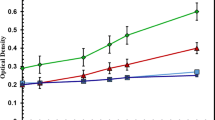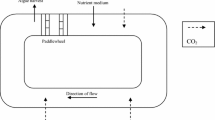Abstract
Microalgae are recognised as promising feedstock for biofuel production. The feasibility in commercial scale microalgae cultivation could be enhanced by incorporating palm oil mill effluent (POME) as culture medium, for greater biomass growth and lipid production, together with POME bioremediation. The polluting POME is generated massively in Malaysia. POME contains high concentrations of carbon and nutrients, thus it is suitable to be applied for microalgae cultivation. The approach on waste to energy should be advanced. We studied the effects of applying Pseudomonas sp. on Chlorella sorokiniana CY-1 cultivation in POME. Pseudomonas sp. was found effective in POME decolourisation prior to C. sorokiniana CY-1 cultivation. Yet, microalgae biomass and lipid productions were higher in the non-decolourised POME. Pseudomonas sp. was as well-being co-cultivated with C. sorokiniana CY-1 in ratios of microalgae versus bacteria of 1:1; 2:1 and 1:2. Biomass of 2.04 g L−1 and biomass productivity of 185.71 mg L−1 d−1 were attained in ratio of 1:1. Interestingly, the lipid content exhibited was excellent (16.04%), and about twofold higher than other ratios and the control (without bacteria). Fatty acids compositions were dominated by C16:0 (32.49%), C18:1 (24.06%) and C18:2 (20.28%), which were desirable fatty acids for biodiesel production. Effective POME bioremediation achieved with chemical oxygen demand, total nitrogen and total phosphorus removal of 53.7, 55.6 and 77.3%, respectively. Co-cultivation of microalgae and bacteria can be applied in the POME treatment plant. This allows satisfactory biomass and excellent lipid yields for biofuel production, as well as effective wastewater bioremediation.






Similar content being viewed by others
References
Abu-Khader MM, Badran O, Attarakih M (2010) Ballast water treatment technologies: hydrocyclonic a viable option. Clean Technol Environ Policy 13(2):403–413
Bala JD, Lalung J, Ismail N (2014) Biodegradation of palm oil mill effluent (POME) by bacterial. Int J Sci Res Publ 4(3):502–511
Cea M, Sangaletti-Gerhard N, Acuna P, Fuentes I, Jorquera M, Godoy K, Osses F, Navia R (2015) Screening transesterifiable lipid accumulating bacteria from sewage sludge for biodiesel production. Biotechnol Rep (Amst) 8:116–123
Cheah WY, Show PL, Chang JS, Ling TC, Juan JC (2015) Biosequestration of atmospheric CO2 and flue gas-containing CO2 by microalgae. Bioresour Technol 184:190–201
Cheah WY, Ling TC, Juan JC, Lee DJ, Chang JS, Show PL (2016a) Biorefineries of carbon dioxide: from carbon capture and storage (CCS) to bioenergies production. Bioresour Technol 215:346–356
Cheah WY, Ling TC, Show PL, Juan JC, Chang JS, Lee DJ (2016b) Cultivation in wastewaters for energy: a microalgae platform. Appl Energy 179:609–625
Chen Y, Tang X, Kapoore RV, Xu C, Vaidyanathan S (2015) Influence of nutrient status on the accumulation of biomass and lipid in Nannochloropsis salina and Dunaliella salina. Energy Convers Manag 106:61–72
Chen CY, Kao PC, Tan CH, Show PL, Cheah WY, Lee WL, Ling TC, Chang JS (2016) Using an innovative pH-stat CO2 feeding strategy to enhance cell growth and C-phycocyanin production from Spirulina platensis. Biochem Eng J 112:78–85
Cho DH, Ramanan R, Heo J, Lee J, Kim BH, Oh HM, Kim HS (2015) Enhancing microalgal biomass productivity by engineering a microalgal–bacterial community. Bioresour Technol 175:578–585
Chouinard-Dussault P, Bradt L, Ponce-Ortega JM, El-Halwagi MM (2010) Incorporation of process integration into life cycle analysis for the production of biofuels. Clean Technol Environ Policy 13(5):673–685
Cucchiella F, D’Adamo I, Gastaldi M (2014) Financial analysis for investment and policy decisions in the renewable energy sector. Clean Technol Environ Policy 17(4):887–904
De-Bashan LE, Moreno M, Hernandez JP, Bashan Y (2002) Removal of ammonium and phosphorus ions from synthetic wastewater by the microalgae Chlorella vulgaris coimmobilized in alginate beads with the microalgae growth-promoting bacterium Azospirillum brasilense. Water Res 36(12):2941–2948
Guo Z, Tong YW (2013) The interactions between Chlorella vulgaris and algal symbiotic bacteria under photoautotrophic and photoheterotrophic conditions. J Appl Phycol 26(3):1483–1492
Igliński B, Piechota G, Iglińska A, Cichosz M, Buczkowski R (2015) The study on the SWOT analysis of renewable energy sector on the example of the Pomorskie Voivodeship (Poland). Clean Technol Environ Policy 18(1):45–61
Jais NM, Mohamed RMSR, Al-Gheethi AA, Hashim MKA (2016) The dual roles of phycoremediation of wet market wastewater for nutrients and heavy metals removal and microalgae biomass production. Clean Technol Environ Policy 19(1):37–52
Jiaqiang E, Liu T, Yang W, Li J, Gong J, Deng Y (2016) Effects of fatty acid methyl esters proportion on combustion and emission characteristics of a biodiesel fueled diesel engine. Energy Convers Manag 117:410–419
Lee J, Cho DH, Ramanan R, Kim BH, Oh HM, Kim HS (2013) Microalgae-associated bacteria play a key role in the flocculation of Chlorella vulgaris. Bioresour Technol 131:195–201
Li Y, Chen YF, Chen P, Min M, Zhou W, Martinez B, Zhu J, Ruan R (2011) Characterization of a microalga Chlorella sp. well adapted to highly concentrated municipal wastewater for nutrient removal and biodiesel production. Bioresour Technol 102(8):5138–5144
Liu G, Shi H, Ping Q, Zhou J, Zhang J, Li N, Niu M, Fatehi P, Xiao H, Ni Y (2013) Complex formation of PEO and lignin in prehydrolysis liquor and its enhancing effect on lignin removal. BioResources 8(3):4004–4015
Liu J, Wu Y, Wu C, Muylaert K, Vyverman W, Yu HQ, Munoz R, Rittmann B (2017) Advanced nutrient removal from surface water by a consortium of attached microalgae and bacteria: a review. Bioresour Technol 241:1127–1137
Moreno-Garcia L, Adjallé K, Barnabé S, Raghavan GSV (2017) Microalgae biomass production for a biorefinery system: recent advances and the way towards sustainability. Renew Sustain Energy Rev 76:493–506
Olguin EJ (2012) Dual purpose microalgae–bacteria-based systems that treat wastewater and produce biodiesel and chemical products within a biorefinery. Biotechnol Adv 30(5):1031–1046
Passell H, Dhaliwal H, Reno M, Wu B, Ben Amotz A, Ivry E, Gay M, Czartoski T, Laurin L, Ayer N (2013) Algae biodiesel life cycle assessment using current commercial data. J Environ Manage 129:103–111
Resdi R, Lim JS, Kamyab H, Lee CT, Hashim H, Mohamad N, Ho WS (2016) Review of microalgae growth in palm oil mill effluent for lipid production. Clean Technol Environ Policy 18:2347–2361
Rivas MO, Vargas P, Riquelme CE (2010) Interactions of Botryococcus braunii cultures with bacterial biofilms. Microb Ecol 60(3):628–635
Saha M, Eskicioglu C, Marin J (2011) Microwave, ultrasonic and chemo-mechanical pretreatments for enhancing methane potential of pulp mill wastewater treatment sludge. Bioresour Technol 102(17):7815–7826
Sari AA, Kurniawan HH, Nurdin M, Abimanyu H (2015) Decolorization of black liquor wastewater generated from bioethanol process by using oil palm empty fruit bunches. Energy Proc 68:254–262
Selvaratnam T, Henkanatte-Gedera SM, Muppaneni T, Nirmalakhandan N, Deng S, Lammers PJ (2016) Maximizing recovery of energy and nutrients from urban wastewaters. Energy 104:16–23
Sethi S, Datta A, Gupta BL, Gupta S (2013) Optimization of cellulase production from bacteria isolated from soil. ISRN Biotechnol. https://doi.org/10.5402/2013/985685
Su CH, Giridhar R, Chen CW, Wu WT (2007) A novel approach for medium formulation for growth of a microalga using motile intensity. Biores Technol 98(16):3012–3016
Tan CH, Cheah WY, Ling TC, Show PL, Juan JC, Chang JS (2015) Algae cultivation in wastewater for biodiesel—a review. Chem Eng Trans 45:1393–1398
Van Wagenen J, Pape ML, Angelidaki I (2015) Characterization of nutrient removal and microalgal biomass production on an industrial waste-stream by application of the deceleration-stat technique. Water Res 75:301–311
Villar A, Arribas JJ, Parrondo J (2011) Waste-to-energy technologies in continuous process industries. Clean Technol Environ Policy 14(1):29–39
Wang R, Xue S, Zhang D, Zhang Q, Wen S, Kong D, Yan C, Cong W (2015) Construction and characteristics of artificial consortia of Scenedesmus obliquus-bacteria for S. obliquus growth and lipid production. Algal Res 12:436–445
Wenzel H (2009) Biofuels: the good, the bad, the ugly—and the unwise policy. Clean Technol Environ Policy 11(2):143–145
Whitton R, Le Mevel A, Pidou M, Ometto F, Villa R, Jefferson B (2016) Influence of microalgal N and P composition on wastewater nutrient remediation. Water Res 91:371–378
Zhang Y, Su H, Zhong Y, Zhang C, Shen Z, Sang W, Yan G, Zhou X (2012) The effect of bacterial contamination on the heterotrophic cultivation of Chlorella pyrenoidosa in wastewater from the production of soybean products. Water Res 46(17):5509–5516
Zhang K, Pei Z, Wang D (2016) Organic solvent pretreatment of lignocellulosic biomass for biofuels and biochemicals: a review. Biores Technol 199:21–33
Acknowledgements
This work is supported financially by the University of Malaya Grant Postgraduate Research Grant PPP (PG093-2014B) SATU Joint Research Scheme (RU018J-2016, RU018L-2016, RU018O-2016, RU018C-2016, ST001-2017, ST002-2017, ST003-2017, ST004-2017, ST005-2017, ST006-2017 and RP031B-15AET), TGRS Grant (TR001A-2015A) and My Brain 15.
Author information
Authors and Affiliations
Corresponding author
Rights and permissions
About this article
Cite this article
Cheah, W.Y., Show, P.L., Juan, J.C. et al. Waste to energy: the effects of Pseudomonas sp. on Chlorella sorokiniana biomass and lipid productions in palm oil mill effluent. Clean Techn Environ Policy 20, 2037–2045 (2018). https://doi.org/10.1007/s10098-018-1505-7
Received:
Accepted:
Published:
Issue Date:
DOI: https://doi.org/10.1007/s10098-018-1505-7




